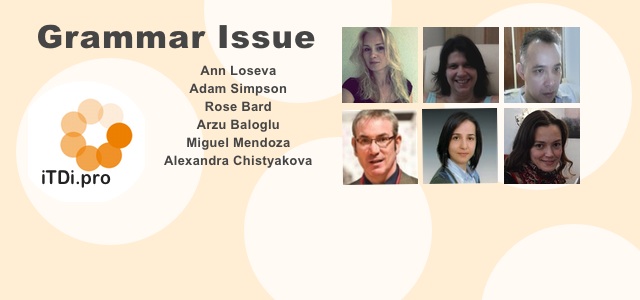
Grammar: tedious or fun? – Arzu Baloglu

Teaching grammar is a subject I’ve been struggling ever since since I started teaching.When I first started teaching English, I thought the most convenient way to teach the language was to write grammar rules and a few example sentences on the board and make students write them down in their notebooks , later do some drilling, oral repetition and lots of worksheet exercises and finally end the lessons. It was that easy, because I had been taught in this way and other colleagues had been teaching in this very teacher centered way.
In my first years of teaching. it was the easiest way for me because the classes I taught were crowded and there were class management issues I had to handle. Also, there was no support or mentoring from the experienced colleagues in my school. I was all alone, dependent on the coursebooks and grammar woksheets. That is, teaching only grammar with lots of repetition made me not only feel more secure but also helped me manage the students,because they were already accustomed to this kind of learning.
Yes it was the most manageable way but not the correct way. I wasn’t satisfied at all. This repetition and monotony bored me much more than the students. There must have been other ways of teaching and I had to find them. Besides,I wasn’t sure if the students were really learning.
Having searched for some class activities, attended some seminars, and learned from some great educators, I decided to try some class activities with my students.The result was excellent. Students both enjoyed and were engaged, and I was pleased with the result. Therefore ,in every lesson plan I made I tried including some games, songs, and puzzles so that I could make the lessons more efficient. Although it was more fun and useful to include some engaging activities while teaching grammar and students definitely enjoyed the lessons, some of my colleagues didn’t see the point and thought I was not a very good teacher. because I wasn’t teaching the grammar rules to students properly. According to the majority of teachers here (in Turkey), grammar is the most important aspect of the language and a great deal of attention must be given to it. I can remember once that a colleague of mine complained to the administration that I wasn’t qualified enough to teach grammar because I hadn’t made the students copy the rules in their notebooks. Maybe it’s true that I’m not good at teaching grammar. On the other hand, I know that I am happier now by not teaching grammar only.
I have been teaching grammar for a long time now. Honestly,I find teaching other language skills such as writing, speaking, and listening easier and more enjoyable. And also I’m still learning to teach grammar more effectively. Even though I haven’t found the effective method yet, I have some class activities, songs and web tools that foster students’ learning, engagement and motivation in classes. I’ve been compiling them from various sources such as other educators’ blog posts, teachers’ book resources, and the seminars , workshops and webinars I’ve attended. Here are some of the activities I use frequently in classes.
The first one is the well-known ‘Find someone who….’activity. You can adapt it into various grammar structures and also it requires students’ participation, which makes them practise what they learn. They simply need to walk around class and ask their classmates some questions and fill in the handout. Here are my handouts. Feel free to use and adapt them. https://app.box.com/s/sq1kc201rzof6tpyvd57 https://app.box.com/s/ev2t3xedidz7w4vhawzi
The next one works best when practising ‘Relative Clauses’. It’s an activity I first found in one of the teachers resource boks I have. Divide the class into groups of four or five and hand out some cards on which some object, people or place names are written. Students must write three definitions for these names and only one of them must be true. The other groups must find the correct definition. This activity is very competitive and fun. You can also try this activity by giving students a list of words and get them to search their meanings and write their definitions in their own words. If you want to use tech, students can look up their meanings on their mobile phones or tablets as well .You can check out my handout here. https://app.box.com/s/ljomu55ujm02kan0qy8r
The other one is a fun activity which I’ve learned from a colleague. You can use it when teaching any language point. Write a sentence in big fonts on a piece of paper and cut all the elements of the sentence. Mix them and give to a student and ask him/her to put them in the correct order to make a sentence in one minute. While he/she tries to put them into the correct order, another student always utters something nonsense (la,la,la or blah,blah,) to distract him/her. You can also make this activity more competitive by dividing the students into teams.

In addition , songs can be one of the most impactful ways to teach vocabulary and grammar . Moreover, they can be used as warmers or fillers .You can use the song ‘Tom’s Diner’ to practise ‘present continuous tense’,’My baby shot me down’ for ‘simple past tense’ and ‘would’ and ‘If I were a boy’ to teach ‘the conditionals’.Here is one of the song lyrics . https://app.box.com/s/n8e4v1g2wp3dyub9rjz2
We cannot ignore the fact that grammar is necessary. On the other hand, our aim shouldn’t be to teach grammar rules only .Instead, we can make the lessons more attractive through some meaningful class activities. As you get to know your students you can adapt and blend the activities into their needs and learning processes. Frankly, I haven’t found the most effective way yet and I don’t know if there is one but at least I’m trying to do my best to facilitate learning. You can try to break the boredom of the grammar lessons as well as creating such an engaging and student-centered atmosphere by avoiding repetition and routines .

If you seel some useful ideas, iTDi is one of the perfect places where you can find lots of help and mentoring to develop your teaching skills. It has helped me a lot and I’ve been learning lots of new ideas from colleagues all over the world. Please don’t hesitate to join in and connect with the great educators here.
Connect with Ann, Adam, Alexandra, Arzu, Rose, Miguel, and other iTDi Associates, Mentors, and Faculty by joining iTDi Community. Sign Up For A Free iTDi Account to create your profile and get immediate access to our social forums and trial lessons from our English For Teachers and Teacher Development courses.

















